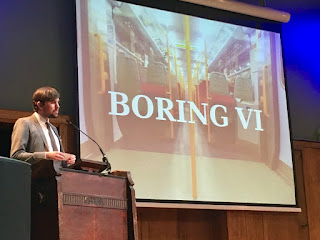What are the first things you think of when you hear the
word presentation? If you are like me your first reaction might be “Ugh.”
Having to sit through another boring lecture, hearing someone drone on and on
about something you don’t even care about, wasting time when you could be
working on something else, or maybe realizing at the end of the presentation
that you didn’t even learn anything or could have read it all on your own.
During my years of school there were certain tips to follow
when developing PowerPoint presentations and I’m sure you can recall some of
these as well:
1.
Limit text on the slide-No paragraphs
2.
Use appropriate charts
3.
Limit animation and transitions
4.
Have a visual theme and choose fonts and colors
accordingly
I have found that these tips still hold true in the procurement profession when developing
a Presentation for a stakeholder. A stakeholder’s time is valuable. They don’t have hours
on end to listen to another presentation and even more than that, you don’t
want them to come out of the presentation and have their only take away be “So,
can you summarize that for me,” or “So bottom line, what are you trying to
convey.”
A PowerPoint presentation is meant to support what you are
saying to your audience. The visuals and charts are to be used as tools to
illustrate certain points. The presentation however, isn’t meant to have your
script on the screen.
As a procurement professional, when developing a presentation for a stakeholder, it is best to
put yourself in their shoes. Think about what they really want to get out of
the meeting. Often times an executive listening to your presentation is going
to want to know high level what you are presenting, what are the key takeaways,
what are they getting out of it, and what are your recommends/next steps. Some
of the best presentations I have listened to have been TED talks and there is
tremendous value in utilizing their public speaking tips.
Here are just a few to think about:
- Don’t defer answering questions- During a presentation stakeholders might ask something either relevant to what you are talking about or relating to a different topic entirely, but you shouldn’t defer their question. The question means they are listening, but deferring to only taking questions at the end, they might be totally turned off by that response and then disengaged
- Create contingency plans- Plan for the what if. What if the projector fails or your audience isn’t engaged? Plan for those fears and address them.
- Share a story- This one is huge to me…which is why it is in bold. The average audience has an attention span of five minutes and you have 15 seconds to make a good first impression. From an article written by Business Insider regarding data by Quantified Communications, messages that included a well-crafted story were 35 percent more persuasive than the average communication and these story based messages were also 21 percent more memorable. Work to incorporate stakeholder testimonials and past experience examples into your presentation. It not only helps the listener pay attention, but also exemplifies your expertise and knowledge of the topic.
- Pause for 10 seconds- Pause for 2-3 seconds and the audience thinks you lost your train of thought, pause for 5 and the audience thinks its intentional, but pausing for 10, even those who aren’t paying attention can’t help but notice. The audience then assumes you are a confident and accomplished speaker.
- Always, always run short- If you have 30 minutes, take 25, if you have an hour take 50, respect the stakeholder's time and as a bonus shortening your presentation forces you to hone in your skills.
The next presentation you give, incorporate these ideas. And
when developing your presentation, stop and think about what message you are
trying to convey and what tools/support is needed to illustrate that message.
Is it necessary to have a PowerPoint? Is it better to show your data in excel
and have a couple support charts and graphs? Is this something you can speak
to? Can you incorporate a story that illustrates your expertise and gets the
message across?


Post A Comment:
0 comments so far,add yours